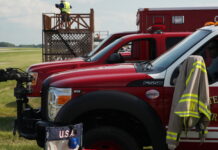In the spring of 2014, ICAS developed and distributed a short, practical recommendation for conducting an emergency response drill on the rehearsal day (typically Friday) of an air show (click here for this one-page document.) Later that summer, these recommendations were incorporated into the new U.S. Air Force protocol on fire emergency services at air shows held on Air Force installations. (Click here to review the Air Force Aircraft Rescue and Fire Fighting Response Guide and pay particular attention to Section 5 beginning on page 12.)
In the nearly two years since ICAS made those recommendations, many shows – both civilian and military – have begun conducting this emergency response drill during their Friday rehearsal shows. And interesting observations and lessons learned from those drills have begun to drift back to ICAS headquarters.
Air shows are finding these exercises to be helpful and enlightening. Event organizers and air bosses are finding that an accident simulation provides an opportunity to identify problems or complications in the emergency response plan. In several cases, ICAS has been told that, during the drill, the emergency response was significantly longer than the anticipated 60 seconds because unforeseen obstacles were encountered that slowed the response to, in some cases, three or even four minutes. Fortunately, these challenges were identified during the Friday drill so that they could be corrected for the balance of the rehearsal show and the actual air show on Saturday and Sunday.
And all of these shows have this to say to their colleagues: If you think you know your plan so well that you don’t need a drill, that’s a good indication that you need to run the drill. Invariably, at least one or two things don’t go as planned and the simulated emergency gives everybody an opportunity to make adjustments that ensure you won’t have those same problems if a genuine emergency develops.
And, if you think that an emergency drill will suggest to members of the press that your event is dangerous, event organizers have told us that they find the opposite. If you make it clear that the exercise is a simulation and not an actual emergency, the press understands and considers it to be an indication of professionalism and preparedness.








